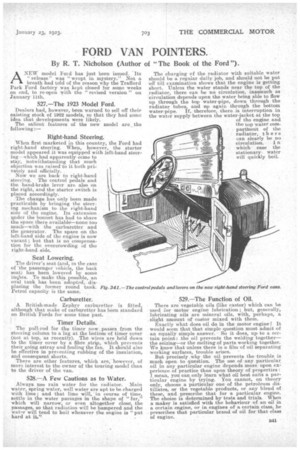FORD VAN POINTERS.
Page 27

If you've noticed an error in this article please click here to report it so we can fix it.
By R. T. Nicholson (Author of "The Book of the Ford ").
ANEW model Ford has just been issued. Its " release" was " wropt, in mystery." Not a breath had told of the reason why the Trafford Park Ford factory was kept closed for some weeks on end, to re-open with the "revised version " on January lith.
527.—The 1923 Model Ford.
Dealers had, however, been warned to sell off their existing stock of 1922 models, so that they had some idea that developments were likely.
The salient features of the new model are the following :—
Right-hand: Steering.
When firsb marketed in this country, the Ford had right-hand steering. When, however, the starter model appeared it was equipped with left-hand steering--which had apparently Genie to stay, notwithstanding that much objection was raised to it both privately and officially.
Now we are back to right-hand 'steering. The control pedals and the. hand-brake lever are also on the right, and the starter switch is placed accordingly. The change has only been made practicable by bringing the steering mechanism to the right-hand side of the engine. Its extension under the bonnet has had to share the space there available—none too much—with the carburetter and the generator. The space on the left-hand side of the engine is now vacant ; but that is no cOmpensa, tion for the overcrowding of the right-hand side.
Seat Lowering.
The driver's seat (and, in the case of the passenger vehicle, the back -seat) has been lowered by some inches. To make this possible, an oval tank has been -adopted, displacing the former round tank. Petrol capacity is the same.
Carburetter.
A British-made Zephyr carburetter is fitted, although that make of carburetter has been standard on British-Fords for some time past.
Timer Details.
The pull-rod for the timer now passes from the steering column to a lug at the bottom of timer cover (not at top, as recently). The wires are held down to the timer cover by a fibre strip, Which prevents their going astray and fouling the fan. It should also be effective in preventing rubbing of the insulation, and consequent shorts.
There are other features, which are, however, of more interest to the owner ef the touring model than to the driver of the van.
528.—A Few Cautions as to Water.
Alwaysuse rain water for the radiator. Main water, spring water, well water are apt to be charged with lime ; and that lime wine' in course of time, settle in the water passages in the shape of "fur," which will narrow,. OF even altogether clew, the passages, so that radiation will be hampered and the water will tend to boil whenever the engine is "put hard at it." The charging of the radiator with suitable water should be a regular daily job, and should not be put off till examination shows that the engine is getting short. Unless the water stands near the top of the radiator, there can be no circulation, inasmuch as -circulation depends upon the water being able to flow up through the tap water-pipe, down through the radiator tubes, and up again through the bottom
water-pipe. If, therefore, there is interruption in the water supply between the water-jacket at the top of the engine and the' top water camparthient of the radiator, there can clearly be no circulation. 1 n which ease the stationary water will quickly boil.
529.—The Function of Oil.
There are vegetable oils (like castor) which can be used for motor engine lubrication ; but, generally, lubricating oils are mineral oils, viith, perhaps, a slight amount of castor mixed. with them. Exactly what does oil do in the motor engine? It would seem that that simple question must admit of an equally simple answer. So it does, up to a certain point: the oil prevents the welding together— the seizing—or the melting of parts working together. We know that unless there is a, film of oil separating working surfaces, trouble arises.
But precisely ,why the oil prevents the trouble is much open to question. The use of any particular oil in any particular engine depends more upon experiew of practice than upon theory of properties: I mean, you can only learn what oil best suits a particular engine by trying. You cannot, on theory only, choose a particular one of the petroleum distillates, or the vegetable products, or any blend of these, and prescribe that for a particular engine. The choice is determined by tests and trials. When a maker is satisfied with the behaviour of an oil in a certain engine, or in engines of a certain class, he
• prescribes that particular brand of oil for that class of engine.
































